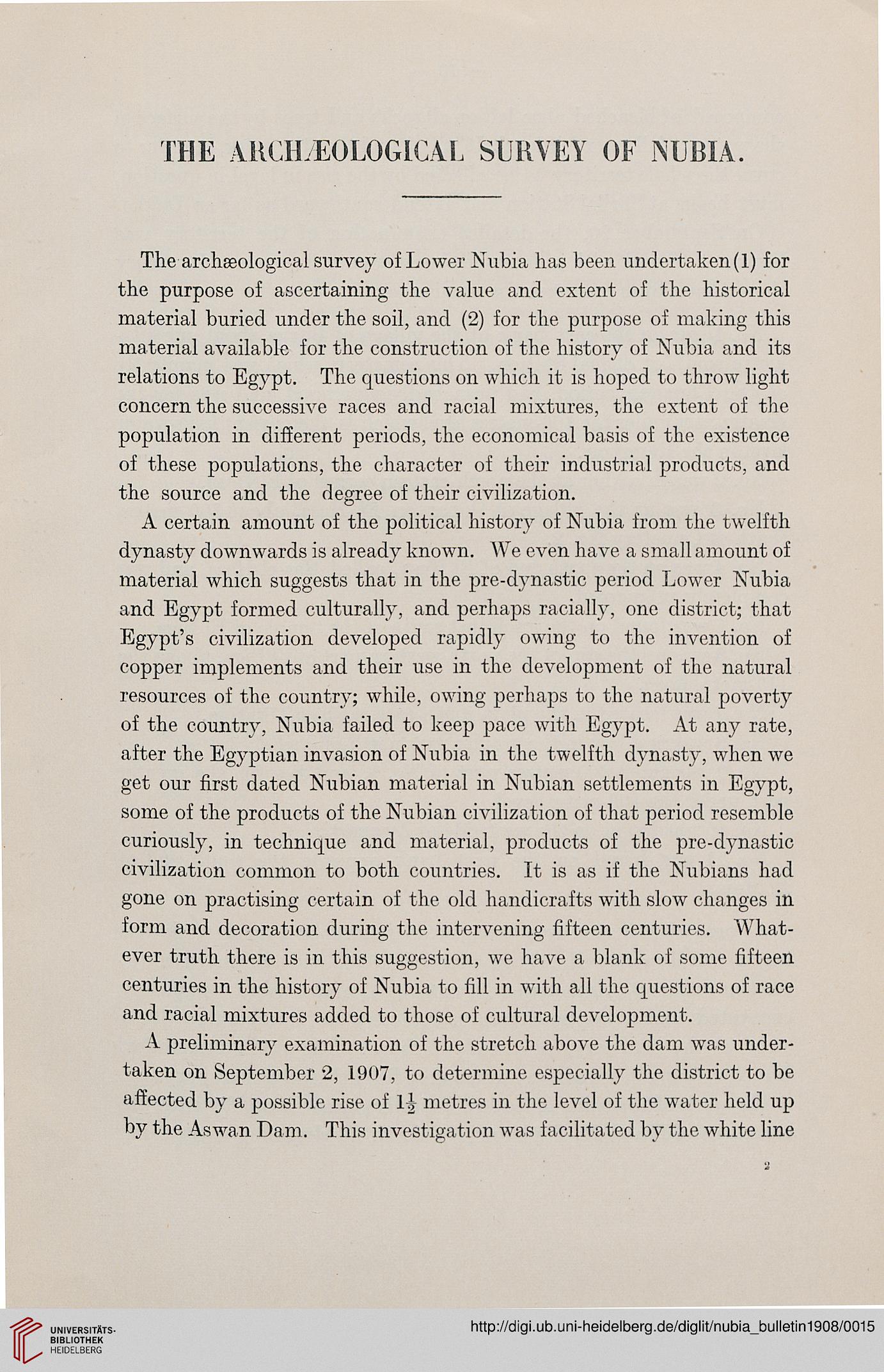THE ARCHAEOLOGICAL SURVEY OF NUBIA.
The archaeological survey of Lower Nubia has been undertaken (1) for
the purpose of ascertaining the value and extent of the historical
material buried under the soil, and (2) for the purpose of making this
material available for the construction of the history of Nubia and its
relations to Egypt. The questions on which it is hoped to throw light
concern the successive races and racial mixtures, the extent of the
population in different periods, the economical basis of the existence
of these populations, the character of their industrial products, and
the source and the degree of their civilization.
A certain amount of the political history of Nubia from the twelfth
dynasty downwards is already known. We even have a small amount of
material which suggests that in the pre-dynastic period Lower Nubia
and Egypt formed culturally, and perhaps racially, one district; that
Egypt's civilization developed rapidly owing to the invention of
copper implements and their use in the development of the natural
resources of the country; while, owing perhaps to the natural poverty
of the country, Nubia failed to keep pace with Egypt. At any rate,
after the Egyptian invasion of Nubia in the twelfth dynasty, when we
get our first dated Nubian material in Nubian settlements in Egypt,
some of the products of the Nubian civilization of that period resemble
curiously, in technicpie and material, products of the pre-dynastic
civilization common to both countries. It is as if the Nubians had
gone on practising certain of the old handicrafts with slow changes in
form and decoration during the intervening fifteen centuries. What-
ever truth there is in this suggestion, we have a blank of some fifteen
centuries in the history of Nubia to fill in with all the questions of race
and racial mixtures added to those of cultural development.
A preliminary examination of the stretch above the dam was under-
taken on September 2, 1907, to determine especially the district to be
affected by a possible rise of l£ metres in the level of the water held up
by the Aswan Dam. This investigation was facilitated by the white line
The archaeological survey of Lower Nubia has been undertaken (1) for
the purpose of ascertaining the value and extent of the historical
material buried under the soil, and (2) for the purpose of making this
material available for the construction of the history of Nubia and its
relations to Egypt. The questions on which it is hoped to throw light
concern the successive races and racial mixtures, the extent of the
population in different periods, the economical basis of the existence
of these populations, the character of their industrial products, and
the source and the degree of their civilization.
A certain amount of the political history of Nubia from the twelfth
dynasty downwards is already known. We even have a small amount of
material which suggests that in the pre-dynastic period Lower Nubia
and Egypt formed culturally, and perhaps racially, one district; that
Egypt's civilization developed rapidly owing to the invention of
copper implements and their use in the development of the natural
resources of the country; while, owing perhaps to the natural poverty
of the country, Nubia failed to keep pace with Egypt. At any rate,
after the Egyptian invasion of Nubia in the twelfth dynasty, when we
get our first dated Nubian material in Nubian settlements in Egypt,
some of the products of the Nubian civilization of that period resemble
curiously, in technicpie and material, products of the pre-dynastic
civilization common to both countries. It is as if the Nubians had
gone on practising certain of the old handicrafts with slow changes in
form and decoration during the intervening fifteen centuries. What-
ever truth there is in this suggestion, we have a blank of some fifteen
centuries in the history of Nubia to fill in with all the questions of race
and racial mixtures added to those of cultural development.
A preliminary examination of the stretch above the dam was under-
taken on September 2, 1907, to determine especially the district to be
affected by a possible rise of l£ metres in the level of the water held up
by the Aswan Dam. This investigation was facilitated by the white line




